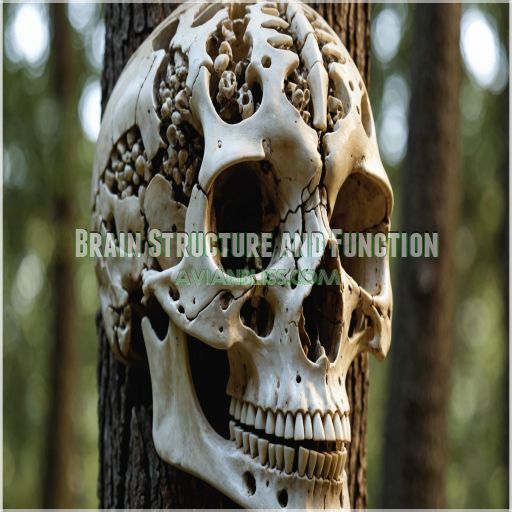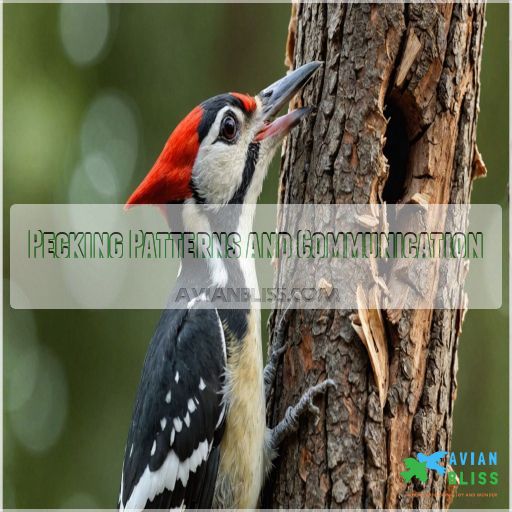This site is supported by our readers. We may earn a commission, at no cost to you, if you purchase through links.

Imagine having the skills of a top detective; woodpeckers hear faint movements and spot their prey with unrivaled accuracy. Their secret weapon? Tail feathers acting like sensors, picking up vibrations that direct them exactly where to peck.
Plus, their brains are wired for speedy decision-making, turning every tap into a precise action. With skulls built like crash helmets, they avoid injury despite striking with powerful force.
Intrigued? There’s more magic behind these expert foragers.
Table Of Contents
- Key Takeaways
- Exceptional Hearing and Vision
- Brain Structure and Function
- Tail Feathers as Sensors
- Pecking Behavior and Techniques
- Role of Skull and Beak Structure
- Ecological Importance and Behavior
- Pecking Patterns and Communication
- Frequently Asked Questions (FAQs)
- How fast do woodpeckers Peck?
- How do woodpeckers know where to peck a tree?
- How do you know if a woodpecker is near you?
- Why do woodpeckers Peck on wood?
- How do woodpeckers choose where to peck?
- What time of day do woodpeckers peck?
- What happens to woodpeckers brains when they peck?
- How does a woodpecker peck so fast?
- How do woodpeckers avoid head injuries?
- What adaptations help woodpeckers find insects?
- Why do woodpeckers drum on houses?
- How fast can woodpeckers peck?
- How are woodpecker nests constructed?
- Conclusion
Key Takeaways
- You know, woodpeckers are like nature’s detectives, using their sharp hearing and sight to zero in on insects hiding under tree bark. Imagine having a GPS in your head to locate your next meal.
- Ever think of a woodpecker as a tiny construction worker with a built-in hard hat? Their skulls are like crash helmets, protecting them from all that headbanging – they’re safer than your dad’s weekend DIY projects.
- With tail feathers that act like vibration sensors, woodpeckers are the ultimate in bird tech. They feel the tiniest tremors, guiding them right to their six-legged snacks – now that’s what you call having your ear to the ground.
- Their drumming isn’t just noise; it’s like sending a text to let everyone know who’s the boss of that tree. They use it to claim territory and even to chat up potential mates – talk about making music with a purpose.
Exceptional Hearing and Vision
You might think a woodpecker just randomly attacks trees, but their exceptional hearing lets them detect the faintest insect movements under the bark.
Coupled with keen vision, these birds combine auditory and visual cues to pinpoint their next meal with impressive accuracy.
Making your occasional clumsy search for the TV remote seem amateur by comparison highlights the remarkable skill of these birds, who use impressive accuracy to locate their next meal.
Detecting Subtle Sounds and Vibrations
Imagine a woodpecker as a tiny detective.
It’s equipped with superb hearing and vibration sensitivity, essential for detecting subtle sounds and vibrations in trees.
This sensory adaptation helps with sound localization, allowing these birds, like the northern flicker, to excel in pest control.
By tuning into these cues, woodpeckers protect their granary trees efficiently, ensuring their survival.
Locating Insects Beneath the Bark
After detecting subtle vibrations, locating insects beneath tree bark becomes woodpeckers’ next challenge.
Their exceptional hearing allows them to pinpoint the exact location of prey, enhancing their hunting prowess.
Combine this with remarkable woodpecker vision, and you’ve got a bird that’s a master at identifying clues like bark vibration analysis and prey detection methods.
These skills keep north America’s forests buzzing!
Combining Auditory and Visual Cues
Woodpeckers are maestros in sensory integration, blending their keen vision and exceptional hearing for precise prey detection, often aided by the presence of insect infestations or loose bark.
They focus on faint sounds and visual feedback to perform directional pecking with astounding accuracy.
By combining these cues, they effectively home in on their targets beneath bark, fine-tuning their pecking path like nature’s precision instruments.
It’s a marvel of evolution!
Brain Structure and Function
You might think woodpeckers have a knack for pecking in just the right spot, but their secret lies in a brain finely tuned to process sensory information.
With a highly developed ability to interpret auditory and vibrational signals, they can make rapid decisions, ensuring each peck hits its mark with precision.
Highly Developed Sensory Processing
You might be amazed by the woodpecker’s highly developed sensory processing.
Its brain is specially adapted to interpret the subtle sounds and vibrations it detects, allowing it to precisely locate insects hidden beneath tree bark.
This rapid decision-making process is essential for the woodpecker’s survival and hunting success.
Interpreting Auditory and Vibrational Signals
Imagine your brain, finely tuned to interpret both sounds and vibrations.
This is where sensory adaptation and brain complexity come into play.
Woodpeckers use their neurological mechanisms to convert these signals into insights about food and predators. It’s like having a superpower for finding hidden treasures beneath the bark, showcasing evolutionary benefits and sensory integration.
Rapid Decision-Making Process
In the woodpecker brain, a rapid decision-making process combines instinct and learned behavior to enhance pecking accuracy.
This involves:
- Processing sensory feedback quickly to adjust movements.
- Predicting impact outcomes to avoid damage.
- Balancing instinct with learning to refine techniques over time.
Despite pecking challenges, these birds master their craft with remarkable precision and efficiency.
Tail Feathers as Sensors
You might be surprised to learn that a woodpecker’s tail feathers are more than just for balance.
They act like sensors.
These specialized feathers transmit vibrations from the tree, helping the bird’s nervous system detect the exact spot where insects are moving beneath the bark.
Transmitting Vibrations to the Central Nervous System
Moving from brain structure, consider the woodpecker’s unique sensory adaptation.
Their tail feathers function as sensors. They reliably detect vibrations, transmitting important data to the nervous system.
| Feature | Function |
|---|---|
| Tail Feathers | Sensory receptors |
| Nervous System | Transmit vibration signals |
| Woodpecker Anatomy | Supports vibration detection |
| Sensory Adaptation | Enhances environmental response |
This ability helps woodpeckers master their pecking precision.
Feeling Vibrations Caused by Insect Movements
After vibrations reach a woodpecker’s central nervous system, those tail feathers take center stage and feel vibrations caused by insect movements.
By detecting these subtle tremors, woodpeckers showcase their impressive sensory adaptation and vibrational sensitivity.
Like nature’s secretive detective, the bird uses insect movement patterns to guide its next peck, continually honing its skills in prey detection and ensuring success.
Enhancing Locational Accuracy
Like having an inbuilt GPS, a woodpecker’s tail feathers act as sensors, enhancing locational accuracy for Precision Targeting.
Vibrational Sensitivity allows these feathers to send Sensory Feedback to the bird’s central nervous system, aiding Adaptive Pecking.
This neural processing helps them pinpoint exact spots on a tree, optimizing energy expenditure while cleverly finding their next meal.
Isn’t that impressive?
Pecking Behavior and Techniques
You won’t believe how woodpeckers know exactly where to peck! These birds employ a rapid-fire pecking technique, drumming on tree trunks to locate their prey with incredible precision and speed.
Rapid-Fire Pecking Technique
Woodpeckers’ rapid-fire pecking technique showcases their pecking speed variation and muscle power.
You’d be amazed by how their strong impact forces are offset by evolutionary adaptations in skull structure to prevent beak wear.
This relentless tapping resembles nature’s very own jackhammer, powerful yet surprisingly efficient, letting woodpeckers explore their wooden universe without missing a beat or damaging themselves, a true testament to their wooden universe.
Drumming on Tree Trunks to Locate Prey
It’s fascinating how woodpeckers locate prey by drumming on tree trunks. They utilize pecking speed and sound patterns to detect insect behavior beneath the bark.
Through sensory integration, these birds choose the right tree, often a hollow or dead one, for maximum resonance.
This technique offers an orchestra of sounds that reveals hidden meals.
Striking With Great Force and Speed
Slamming their beaks with astonishing impact force, woodpeckers utilize unique anatomy adaptations to avoid injuries. You’d imagine it hurts, but:
- Powerful beak strength distributes force.
- Pecking mechanics involve precise control.
- Head deceleration minimizes shock to the brain.
- Plates and spacing in skull structure absorb impacts.
- Their resilience inspires helmet designs for humans.
Role of Skull and Beak Structure
When you consider the woodpecker’s relentless pecking, it’s the bird’s skull and beak structure that truly steals the show, a testament to the evolution of beaks
.
With a robust beak designed for chiseling wood and a shock-absorbing skull, woodpeckers can hammer away without suffering from a headache.
Shock-Absorbing Anatomy and Impact Dissipation
While mastering rapid-fire pecking, woodpeckers rely on evolutionary adaptations for brain protection and impact force dissipation.
Their skulls act like stiff hammers, dispersing energy and preventing injury. The beak structure, which includes the upper and lower mandibles, also plays a key role in shock absorption, similar to how a bird’s beak can be aligned and glued back together in the case of a break.
Remarkably, their bone density and unique cranial features absorb shocks, safeguarding the brain during impacts. This efficient anatomy allows them to thrive, illustrating nature’s remarkable engineering.
Powerful and Robust Beaks for Penetrating Wood
Imagine a woodpecker’s beak as a perfectly crafted chisel.
Its evolution has resulted in a robust, self-sharpening structure that expertly withstands constant impact forces.
The beak’s strength adaptations prevent wear while different shapes allow varied pecking techniques.
This evolutionary marvel means woodpeckers can punch holes in trees without damaging themselves—talk about nature’s incredible toolkit and its ability to withstand constant impact forces.
Unique Skull Design for Reducing Impact Forces
You’ll be amazed by the woodpecker’s specialized skull design that protects its brain from impact forces up to 8 times greater than the skull itself.
Its uneven beak lengths, flexible outer layer, and hyoid "safety belt" divert stresses away from the cranial cavity, allowing these incredible birds to peck with incredible force without sustaining brain injury.
Ecological Importance and Behavior
You might think woodpeckers are just noisy neighbors, but their pecking plays a significant role in maintaining forest health.
By creating cavities for nesting, they contribute to ecological balance.
By controlling insect populations, they help the survival of many species.
Creating Cavities for Shelter and Nesting
Woodpeckers create cavities for nesting by carefully pecking wood, offering shelter with the right cavity size, a result of their remarkable woodpecker behavior
.
They often choose dead trees, which are easier to excavate and strategically position cavities for safety and warmth.
Using soft nest materials like wood chips, they prepare for the breeding season, ensuring nesting success by creating a cozy home for their young (Source).
Regulating Insect Populations in Forests
As you explore how woodpeckers carve cavities, consider their knack for regulating insect populations.
Their diet, rich in larvae and pests, makes them natural exterminators.
These birds employ effective insect control methods, enhancing forest health benefits.
Through predation on insects, woodpeckers impact biodiversity positively, keeping tree-damaging pests in check and fostering a more balanced ecosystem.
Contributing to Ecosystem Balance and Health
After minimizing insect threats, woodpeckers contribute greatly to ecosystem balance.
Their cavity nesting creates essential shelters for various species, enhancing biodiversity.
By decomposing dead wood, they promote forest decay, which leads to tree health and habitat balance.
These natural engineers help sustain ecosystems, ensuring that forests remain vibrant and full of life (Source).
Pecking Patterns and Communication
You might think woodpeckers are merely noisy neighbors, but their drumming serves as a clever communication tool, essential for claiming territory and attracting mates.
These rhythmic pecking patterns also vary with the seasons, adding an interesting twist to their already fascinating behavior.
Drumming on Hard Surfaces for Communication
Imagine you’re a woodpecker.
You drum on hard surfaces to communicate drumming frequencies that rival Morse code, forming a unique language.
This isn’t just noise; it’s an intricate broadcast system for bird communication signals and mating displays
.
Even dead trees become nature’s drum sets, each echo connecting woodpeckers across forests, like their version of echolocation.
Claiming Territory and Attracting Mates
Woodpeckers drum on resonant objects to claim territory and attract mates. Their distinctive pecking patterns convey messages about availability and dominance, which is essential for male woodpeckers as they use drumming to attract mates and establish their unique drumming signature woodpecker male and female.
You’ll hear:
- Irregular, stop-start rhythms from red-breasted sapsuckers
- Fast, steady drum-rolls from hairy woodpeckers
- Slow, deliberate taps from downy woodpeckers
These drumming displays are a key part of woodpecker courtship and communication, allowing them to find partners and defend their homes.
Seasonal Patterns and Behavioral Variations
Territory claims roll seamlessly into seasonal behaviors. You’ll notice woodpeckers ramp up their drumming intensity during seasonal mating, communicating energy and readiness.
Winter foraging introduces precision pecking for insects under bark. Nest building showcases their architectural skills, using beak and skull as tools.
Migration patterns, however, vary. Some stay put, while others set off on long journeys (Source).
Frequently Asked Questions (FAQs)
How fast do woodpeckers Peck?
A woodpecker can peck up to 20 times per second, hitting a total of 8,000-12,000 pecks daily. They achieve head speeds of 13-15 mph, cleverly avoiding brain damage through anatomical adaptations.
How do woodpeckers know where to peck a tree?
Whispering winds of woodpecker wisdom help you locate insect sounds within tree bark.
These birds harness heightened hearing to identify the rustling of larvae beneath wood, ensuring food reaches their beaks with impressive precision.
How do you know if a woodpecker is near you?
You can often hear a woodpecker before seeing one.
Listen for drumming or drilling sounds on trees, which indicates their presence.
Check for small holes or damage on tree trunks or wooden structures nearby.
Why do woodpeckers Peck on wood?
Imagine the rhythmic tapping of a woodpecker’s beak against wood.
They peck to find insects, excavate nesting cavities, and communicate their territory.
This behavior is an ingenious adaptation that helps these birds thrive, leveraging their unique beak types and functions Bird Beak Adaptations
.
How do woodpeckers choose where to peck?
Woodpeckers select pecking sites often based on sound cues and vibrations.
They detect insect movements using acute hearing, targeting softer woods like dead trees where insects thrive.
This skill helps them feed efficiently and construct nesting sites.
What time of day do woodpeckers peck?
Early morning marks woodpeckers’ prime pecking time, often at dawn.
They’re mostly active during sunny days from dawn to dusk, but cloudy skies can make them sporadic.
Drumming communicates territories and attracts mates, especially in spring.
What happens to woodpeckers brains when they peck?
Contrary to common belief, woodpeckers’ brains withstand intense impacts due to their small size and evolutionary adaptations rather than special shock absorbers.
These features prevent damage when they peck trees at accelerations far above human concussion levels, especially on types of wood with woodpecker resistant materialswoodpecker resistant materials
.
How does a woodpecker peck so fast?
Birds like woodpeckers can peck rapidly, about 20 times per second, thanks to their specialized skull structure and strong neck muscles.
These adaptations efficiently absorb shock, preventing injury while they focus on feeding and communication .
How do woodpeckers avoid head injuries?
Imagine the woodpecker hammering with relentless precision.
They avoid head injuries by having smaller brains and a unique skull structure that minimizes shock absorption needs, allowing them to tolerate high g-forces without damage.
What adaptations help woodpeckers find insects?
Woodpeckers rely on their chisel-like beaks and extendable tongues to find insects.
They detect insect sounds within wood, use zygodactyl feet for gripping trees, and have reinforced skulls to withstand pecking impacts without injury.
Why do woodpeckers drum on houses?
You might find woodpeckers drumming on houses because they’re marking territory or attracting a mate.
The loud noise from pecking materials like siding or gutters makes it ideal for broadcasting their presence.
How fast can woodpeckers peck?
At a jaw-dropping rate, woodpeckers can peck up to 20 times per second!
That’s like tapping your forehead faster than a drummer’s beat.
They achieve this blistering speed to dig for insects or communicate.
How are woodpecker nests constructed?
Using their strong beaks, woodpeckers create cavity by chiseling into tree trunks or branches.
These nests are void of additional materials but are cushioned by wood chips from excavation, providing a cozy space for raising young.
Conclusion
Just as you’d coincidentally find the last puzzle piece in your pocket, woodpeckers masterfully discover where to peck.
They blend sharp senses, brain power, and specialized anatomy to tap into the hidden world beneath the bark.
With their incredible hearing and vision, tail feathers sensing vibrations, and powerful skull structure, they’ve got the whole package.
By pecking accurately and efficiently, these birds keep the ecosystem in balance while showcasing the marvel of natural adaptation.










